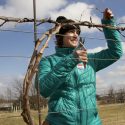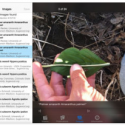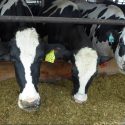New UW–Madison project to support Wisconsin hemp growers
Last year, after the state passed legislation making it legal to grow industrial hemp, around 200 Wisconsin farmers gave it a go.
It proved challenging for many, and UW–Madison agricultural experts in the College of Agricultural and Life Sciences and the Division of Extension did their best to help, gathering and sharing production practices developed in other states that had legalized production earlier. But the need for Wisconsin-specific information was apparent.
“It became clear that we were going to need to do something to increase capacity, to make sure we’re meeting the needs of the folks out there really trying to implement hemp cropping,” says Patrick Robinson, associate dean of agriculture and natural resources in the Division of Extension. “It can take a while to find long-term resources to build capacity in a new area, so we decided to create a more rapid response to this emergent need.”
To respond, CALS and Extension leaders partnered together to fund a one-year research and outreach project to support industrial hemp growers. The leaders solicited project proposals and awarded $35,000 to a project that brings together an interdisciplinary team of CALS/Extension researchers from agronomy, horticulture, soil science, plant pathology, biological systems engineering and agricultural and applied economics, as well as Extension educators in three counties.
On the research side, the project will explore best practices for production and harvest, in organic and conventional systems, across a range of industrial hemp varieties. The outreach component involves a series of field days that will be held at the project’s four field trial sites, which are located at UW’s Arlington Agricultural Research Station in Columbia County, private farms in Buffalo and Iowa Counties, and a county farm in Chippewa County. Research-based information will also be distributed to county-based Extension educators to share with farmers.
“Our goal, as always, is to provide accurate advice on the best agricultural practices for Wisconsin growers,” says project leader Rodrigo Werle, a UW–Madison assistant professor of agronomy and Extension specialist. “When we are talking with growers, we must have solid science behind our recommendations.”
Wisconsin was once a leading producer of industrial hemp, primarily for rope production, until legal production was prohibited by the Marihuana Tax Act of 1938. In 2018, hemp production became legal again in Wisconsin at the state level, overseen by the Wisconsin Department of Agriculture, Trade and Consumer Protection (DATCP) Industrial Hemp Research Pilot Program. The 2018 Farm Bill, which was signed into law in December 2018, reclassified industrial hemp from a narcotic to a commodity crop, making it legal to grow at both the state and federal level—and paving the way for research to begin at the university.
Industrial hemp is a member of the cannabis family, but with low levels of the psychoactive compound tetrahydrocannabinol (THC). Today, farmers grow industrial hemp for fiber, seed and oil. In particular, there is a lot of interest in growing hemp for cannabidiol (CBD), a non-psychoactive compound that is being marketed as a supplement for a wide range of health applications.
In 2018, around 250 farmers applied through DATCP to grow industrial hemp in Wisconsin. This year, more than 1,400 applied.
The UW project’s field trials will look closely at how various agronomic practices affect THC levels in the plants. If the THC concentration rises above the legal limit of 0.3 percent dry weight, the crop must be destroyed. This happened to a number of Wisconsin farmers in 2018. UW researchers hope their research will greatly reduce this risk for farmers.
In particular, there is concern that fertilizers may increase levels of THC. “So we’ll be testing that in research plants,” says Werle.
Last year, the state’s hemp growers struggled to control undesirable plants that competed with the crop. Werle, an expert on controlling unwanted plants in cropping systems, will use the field plots to explore the best control options.
The field days will provide an opportunity for the project’s researchers to share findings from their research plots, as well as to hear challenges and successes from farmers who are growing the crop.
“This work is a partnership with CALS, Extension and the farmers actually doing the production,” says Doug Reinemann, CALS associate dean for extension and outreach. “They’re helping us understand the questions that need to be answered, and we’ll continue to work with them to develop answers.”
In a state where the dairy industry has been struggling for multiple years, there is a lot of hope and excitement that hemp can provide a new source of income for cash-strapped farmers. It’s important, however, to approach hemp with an appropriate amount of caution, say agricultural experts.
“It’s going to be important to figure out the market for the various components of industrial hemp,” notes Reinemann. “How much is each component actually worth and who will be purchasing and processing each product? We need to know this so Wisconsin farmers can figure out if this is a crop that makes sense for them economically.”





